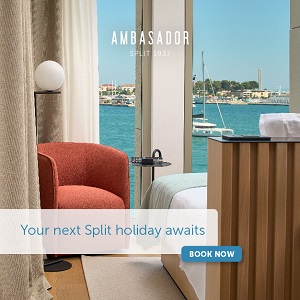Ludbreg Winemakers' Wines Thrive Due to God-Given Microclimate
January 23, 2021 – The feast of St Vincent's Day, Vincekovo, could not be celebrated this year due to the epidemiological situation, but Ludbreg winemakers continue to focus on their wine production. Thanks to the very favorable climate, the Ludbreg area is suitable for planting vineyards, and local winemakers hope to soon get their well-deserved place on the Croatia's wine list.
Vincekovo, which was celebrated yesterday, January 22, in the Ludbreg area, used to be celebrated in Globočec when the plantations were blessed. The main event was a traditional and unique exhibition of young wines from the Ludbreg and surrounding vineyards, which was canceled this year due to strict epidemiological measures and a challenging situation.
It is an additional blow for all caterers who suffered the most in the corona crisis and wine producers. Local winemakers and winegrowers will wait for some better times to meet and rejoice with friends.
Sanja and Tomislav Stručić, top winemakers from Ludbreg, who met with TCN in Ludbreg last year, told their business story for the Epodravina.hr portal.
Family vineyard three kilometers from the center of the world
"We were pleased by the announcement that we could reopen our doors in February, but if we won't open until Easter, as announced, the season is questionable. We are very affected," says winemaker Sanja Stručić.
However, despite the pandemic, wine lovers are not resting. Caring for the vineyards is a year-round work, essential for producing good wine. The season begins now when the first pruning is done and lasts until the harvest.
"Last year, we estimated that, given the situation with the coronavirus, we would have stocks of wine. Therefore, we reduced the grape yield during pruning in the spring. We left grapes for sparkling wine and wines to age. We want to produce quality, not quantity, that is, high-quality wines," says the Stručić family.
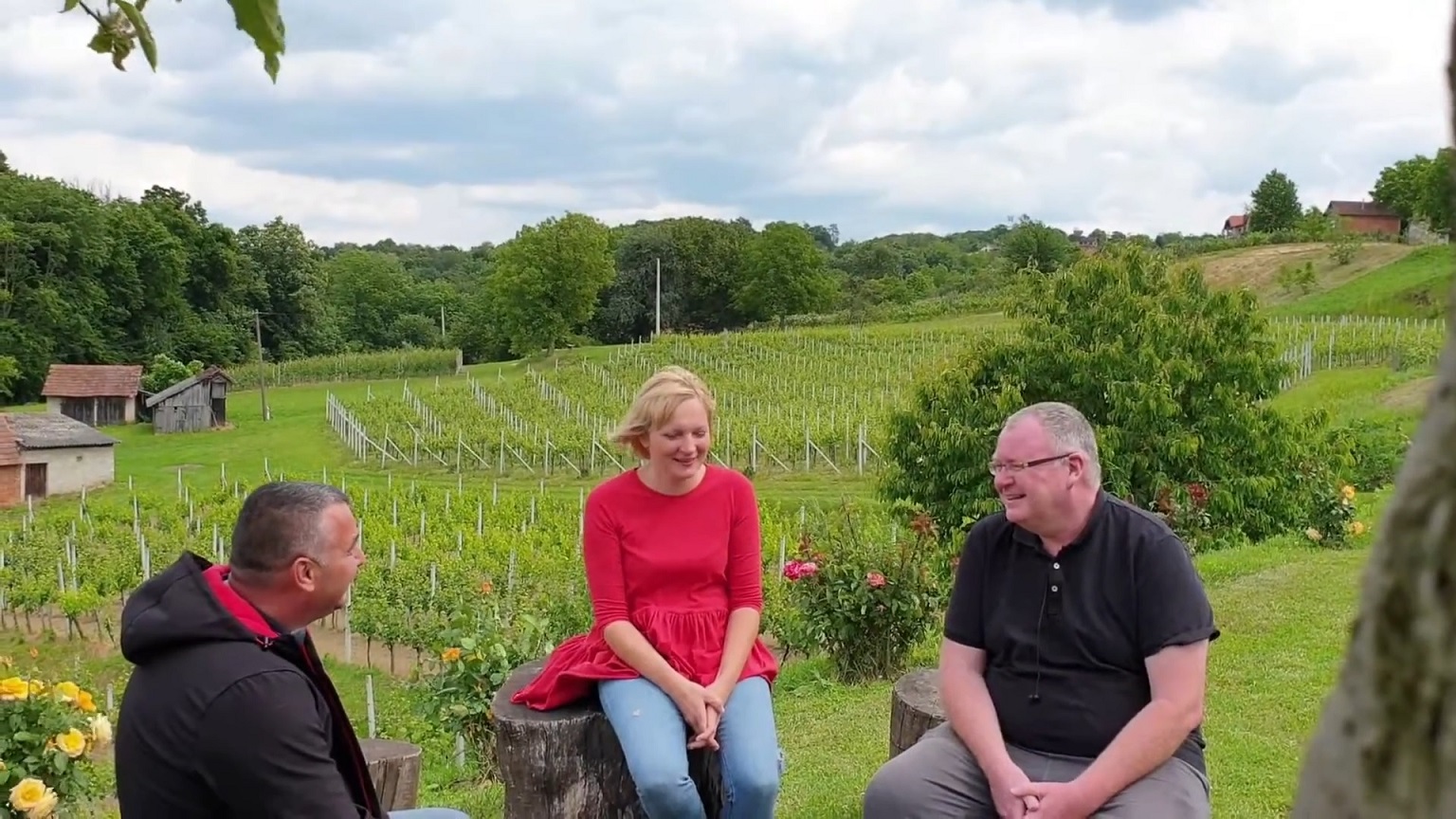
Sanja and Tomislav Stručić with Paul Bradbury in 2020, Total Croatia News
Their beautiful wine-growing hills, clean air, excellent wine, and hospitality evoke the love of land and viticulture that began in 1984 with a family vineyard just three kilometers from the center of the world. Sanja's father, Dragutin Crnković, once planted the first vineyard there, passed on his love of viticulture to his daughter, and introduced her to the wine business.
Emphasis is on the premium line of nature wines
Sanja's husband, Tomislav, also fell in love with winemaking and viticulture. In 2000 they founded the Winery, and in 2017 they produced the first sparkling wine in the region. They are the new wine style leaders in Varaždin County, and today they create top and quality wines.
Stručić Winery has become one of the most famous and successful and began more severe production in 2002. The emphasis is on the premium line of wines represented by nature wines. The premium line consists of carefully selected bunches hand-picked from selected vines. Sanja showed her love, passion, and care for each of these grapes before they become wine.
"Only ripe grapes are picked from the petiole by hand, clean and healthy. Fermentation on own yeasts and grapes, without the addition of selected yeasts, produces natural wines. This top line comes in different bottles and has different labels. We have been making it in small batches, approximately 750 bottles, for four years now, every year with a new vintage," says Sanja.
Back in 2016, Stručić family even produced a special edition of Sara Kolak Chardonnay to celebrate the local Olympic javelin gold-medal winner.
Journalists who encourage stories about gastronomy, tourism, and hedonism are also responsible for the turn in wine production. The Stručić family decided to take advantage of the microclimate and their plantations' position, which enable them to produce excellent raw materials for the production of different wine styles.
"We researched and realized that our region is a microclimatic God-given. While visiting various wine fairs and festivals, we realized we want to make different wines. The exhibitions were an incentive for us to expand our knowledge to be as good as possible. We also visited wineries in Italy to get a better insight into their viticulture and winemaking that is at a high level, and to apply experiences and some wine secrets in our vineyard and cellar," says Sanja on how they started producing sparkling wine and natural wine.
Produced the first sparkling wine in the region
The family vineyard initially had 3,500 vines and was later expanded with new plantations. Today, they cultivate three and a half hectares of land with 14,000 vines. It consists of plots named after the youngest members: Lucija, Luka, and Petra, and the newest plantation was named after their niece Katarina. The plots are registered by varieties and years of planting. The rulers of their vineyard are Graševina, Chardonnay, Rhine Riesling, Sauvignon, Portuguese and Yellow Muscat.
"We produce Graševina, Chardonnay, Sauvignon, Rhine Riesling, and mixed wines. Poštenjak is a blend – a mixture of Graševina, Chardonnay, and Pinot Gris. We make fruit wines and liqueurs, and sparkling wine. We produce about 25,000 bottles a year," says Tomislav.
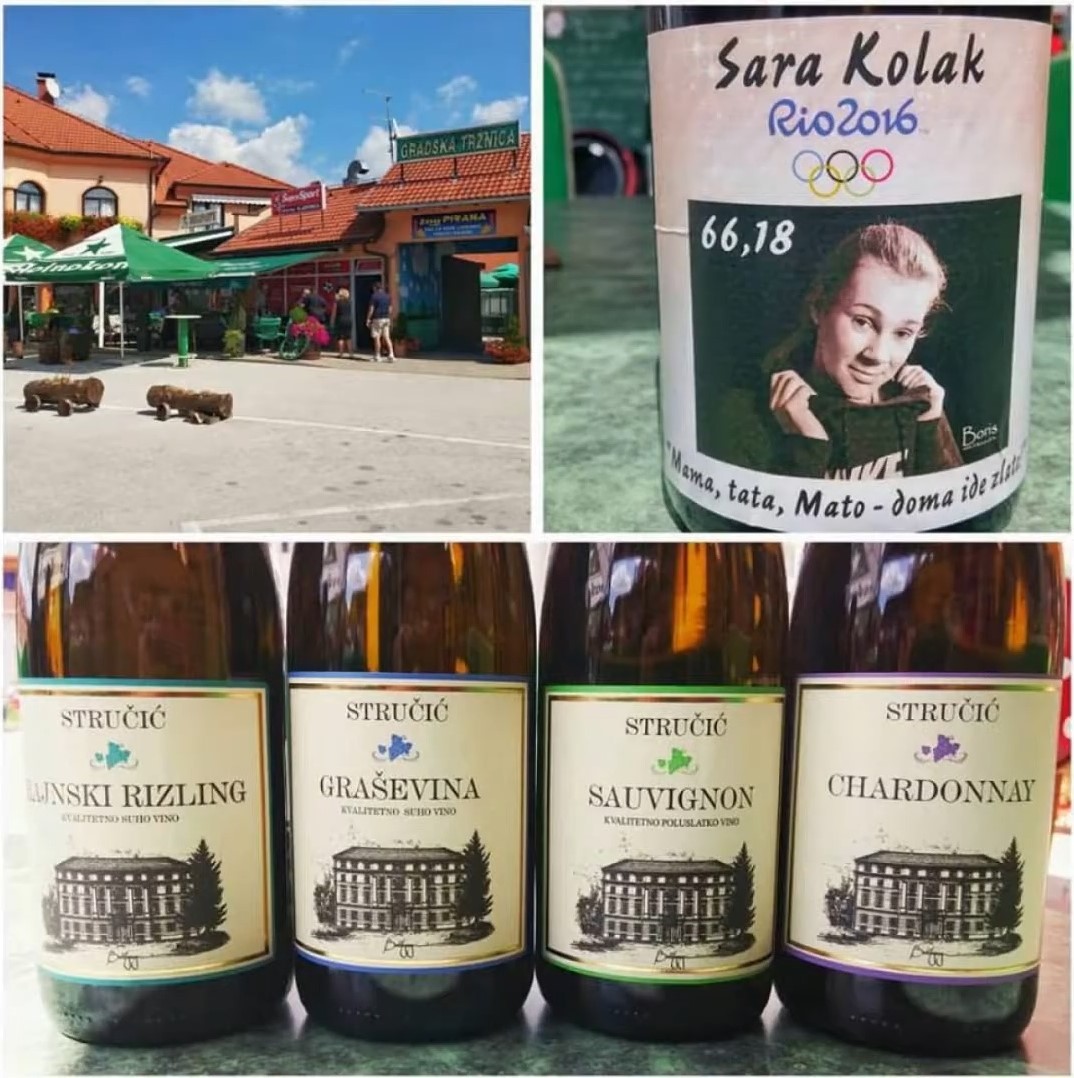
The opening of the Ludbreg Wine Road about ten years ago encouraged a stronger development of their winery. Thus, in 2017, Vinarija Stručić produced the first sparkling wine from the Ludbreg vineyards, which has the label "blanc de blancs" (namely "white from white"), which means that only white grapes were used in its production, that is, Chardonnay.
"After top quality wines, every winemaker wants to produce sparkling wine. It is the crown of your work, as if, for example, you have won the World Cup. The production of sparkling wine was our desire for a step higher. And now, three years ago, we are doing batch after batch," Sanja points out.
The Croatian Wine Institute, which evaluates and issues a quality certificate, rated their sparkling wine as top quality. And there is only five percent of top wines in Croatia, so they expanded their production in 2018 with rose sparkling wine from the Portuguese. It is a unique rarity in Croatia, produced by only one other winemaker on Plješivica.
Microclimatic conditions with a continental climate favor the quality ripening of grapes, so the Podravina and Zagorje regions are God-given for sparkling wine production. The Ludbreg vineyards' climate is ideal for producing light wines with little alcohol, sparkling wine, and wines of late harvests.
Decanter quality certification
Stručić Winery sells its products throughout Croatia. In Ludbreg, visitors can taste their wines in the Bonaparte coffee bar, which they own, as well as the Amalia catering facilities, Pivnica Mejaši, and Hotel Crnković.
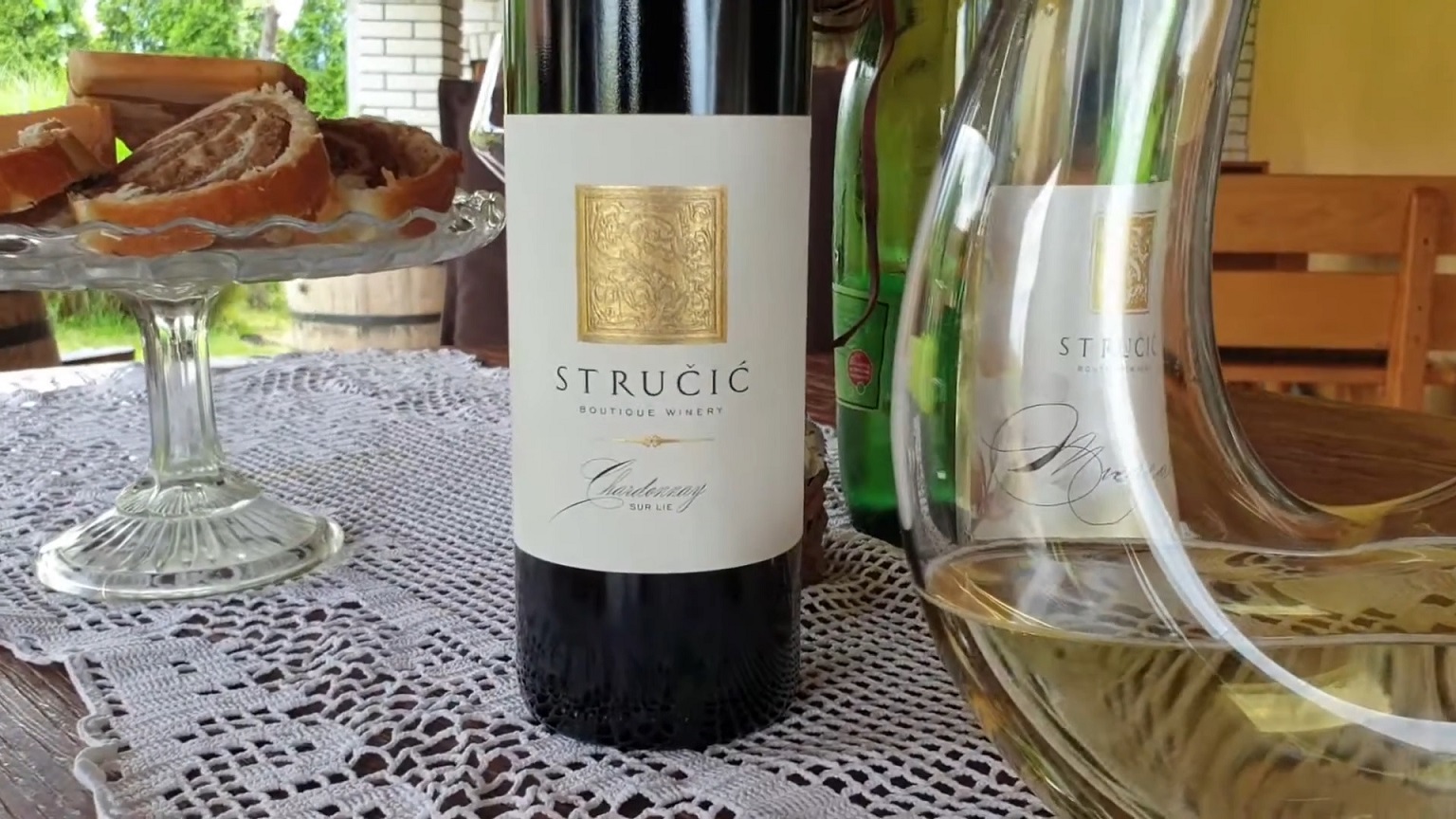
"Rhine Riesling is mostly associated with the name of our winery. It is our flagship and our most sought after wine on the market. Then follow Graševina, Chardonnay, Portuguese, Sauvignon… Premium wine lines, sparkling wines, aged, and nature wines are distributed to the Adriatic coast," says Tomislav.
The secret behind the Sučić Winerys's success, Sanja points out, is harmony, great love, patience, a lot of sacrifices, and constant investments. Proof of quality arrived last August when the Stručić Winery won a bronze medal for Chardonnay and recommendations for Rhine Riesling and Graševina at the most influential wine evaluation – the Decanter World Wine Awards 2020 in London.
"It is a confirmation that we make quality wine. With these recognitions, we have increased visibility," says Tomislav with satisfaction.
Ludbreg vineyards on the wine list of Croatia
For wines to achieve top results, a lot of education, work, and knowledge is needed, so the Stručić family cooperates with the leading Croatian sommelier and Decanter judge Siniša Lasan. With Varaždin County's cooperation, Siniša visited several wineries and tasted wines, discussed problems, and gave his view of the current situation in winemaking in the county.
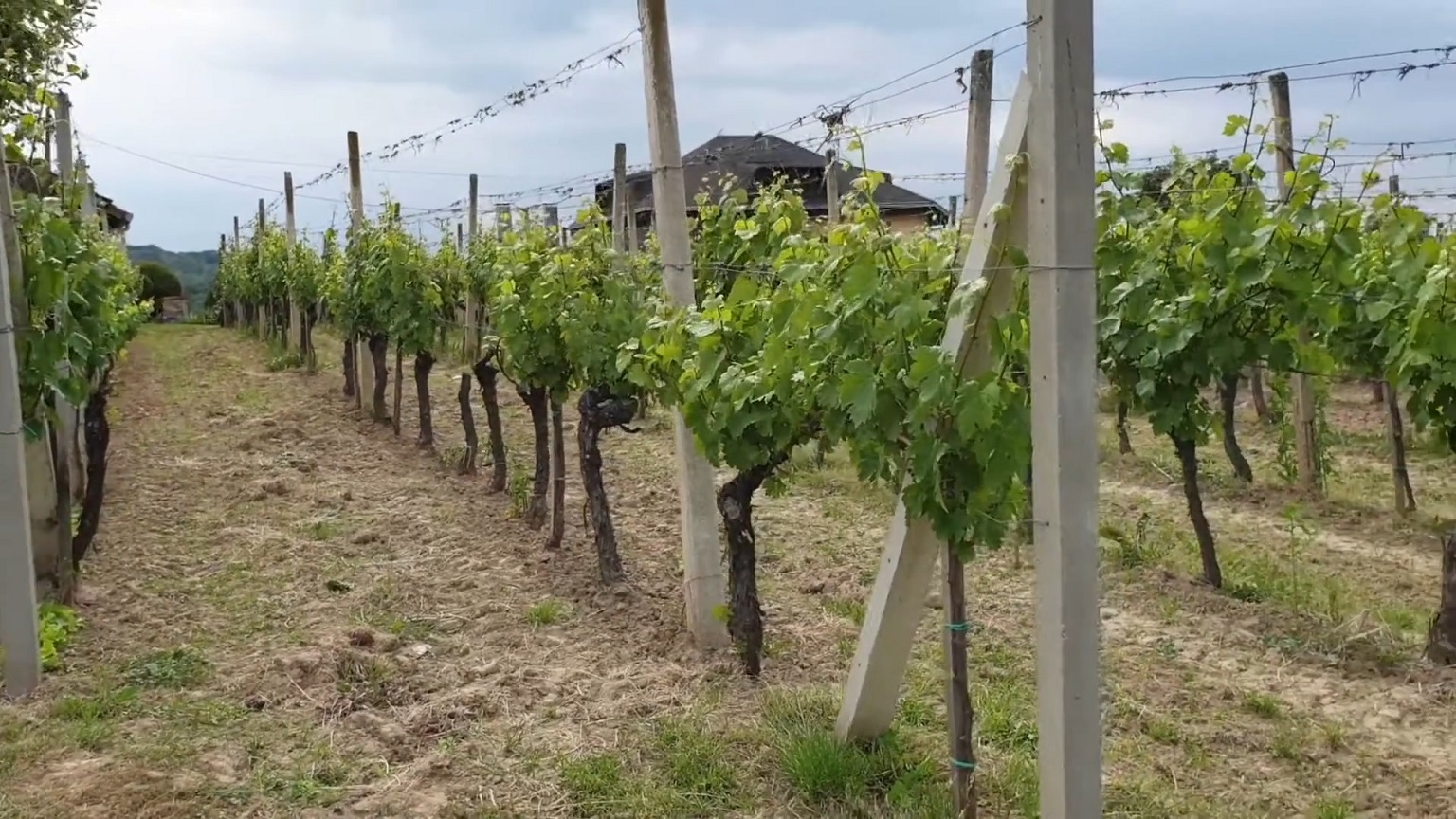
Continental tourism is in the beginning. Tourism Ministry began to give it importance and encourage it only a few years ago.
"The Ludbreg and Varaždin vineyards are neglected. They are not marked on Croatia's wine list, and our winemakers are very hardworking but self-effacing. A dozen of us from all over the county will have to sit down, compare wines, listen to the profession to style them if necessary so that we stand out together with quality. I believe that we will soon mark our vineyards on the wine list, which would raise the price, and we could sell our wines more easily on the doorstep," Sanja is optimistic.
"Viticulture is a demanding activity that requires a lot of attention because wine is alive and should be continuously monitored. Without love for the vineyard and wine, there is no progress, "the Stručić couple agrees.
However, the biggest reward in their work is that the interest in winemaking is shown by their 17-year-old son Luka. He wants to enroll at the Faculty of Agriculture and become a wine expert, oenologist. Thus, when the time comes, to the family's satisfaction, the winery will be taken over by the third generation, which will cultivate, enrich, and further create new top-notch wines.
To read more about Ludbreg, follow our dedicated page.
One Minute Ludbreg: Meet the Ludbreg Wine Road
August 22, 2020 - Although Croatia is a well-known wine-producing region, not every region has its own wine road. Meet one which has, the Ludbreg Wine Road.
It is the land of 130 indigenous grape varieties and the birthplace of the original Zinfandel, whose unique wine offer is attracting more and more international attention.
And yet not every wine-producing region in Croatia has its own wine road. Dalmatia, arguably the most famous Croatian wine region of all (although Istrians may dispute this) does not have an organised wine road that tourists can use to find the finest Plavac Mali or Posip.
One small wine-producing region tucked away in northern Croatia has got itself organised, however, one more example of excellence in the unusual town of Ludbreg, which is better known in Croatia for its claim to fame as the Centre of the World.
The Ludbreg Wine Road has been in existence since 2010 and this year celebrated its 10th anniversary. Local producers have come together to form the Association Trsek, whose mission is the promotion of the region's wines.
All the wine producers and restaurants on the Ludbreg Wine Road are in close proximity, and each offers a different tasting experience of the local grape varieties.
Although perhaps not the best known of wine roads in Croatia, Ludbreg plays an important role in the Croatian wine story. It has been the host to the biggest international wine festival in Croatia for young wines for almost 30 years, and its vineyards have been guarded by the world's largest statue of the Protect of Vineyards, St Vincent - or Sveti Vinko as he is known in Croatian.
Take a tour of the Ludbreg Wine Road in our latest episode of One Minute Ludbreg, before continuing your tour of this fascinating little town in the other videos in the series published so far.
The One Minute Ludbreg video series is a project in paid partnership with the Ludbreg Tourist Board.
To learn more about Ludbreg beyond its stereotype as the centre of the world, read Marc Rowlands' Ludbreg, the Croatian Road Less Travelled.
Visit Ludbreg on the Croatian Road Less Travelled
July 9, 2020 - Continuing the TCN series, The Croatian Road Less Travelled, Marc Rowlands explains why you should visit Ludbreg.
Situated in the far north of Croatia, just south-east of Varaždin and Čakovec and less than 20 kilometres from the border with Hungary, the small and picturesque town of Ludbreg is one of incredible contrasts and one with no small amount of ambition. Its close proximity to such neighbours pales into insignificance when you see the places Ludbreg would rather be judged against - this town is known as the Centre Of The World. The moniker was attributed when it was discovered, by accident, that it lies equidistant between many significant cities. Capitalising on the name, Ludbreg has charted these cities and their distance in a circular stone paving feature which can be found in the town's central square. 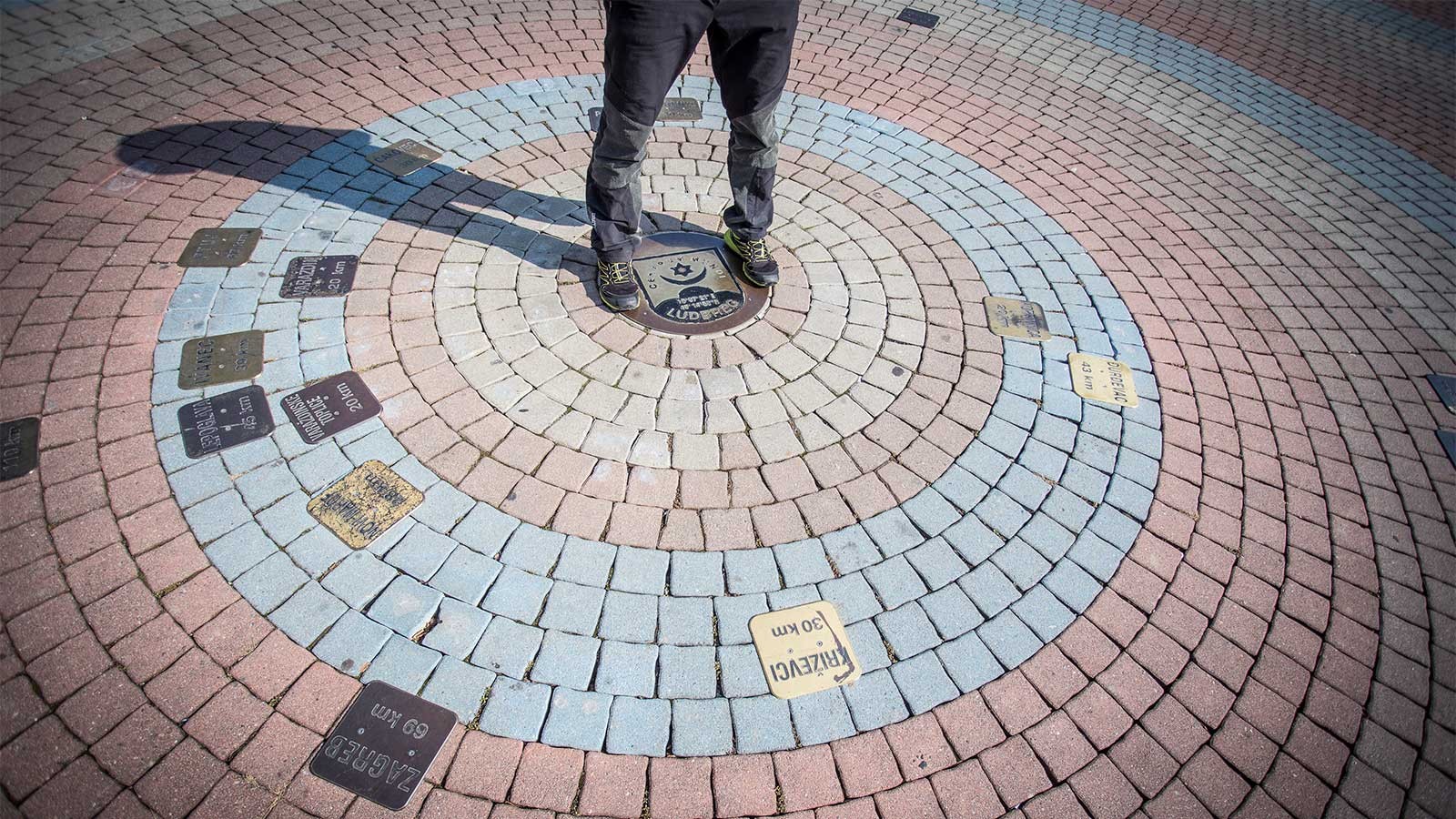
Visit Ludbreg, Centre Of The World © Croatian National Tourist Board / Bojan Markicevic
However, as much as the town might name-check Paris, Athens, Vienna and Budapest on its monument, there's actually no escaping the fact that it is actually a direct product of its local environment. Its close proximity to the river Drava - an important trading route since before Roman times - its major tributary, the river Plitvice, and its placing on the river Bednja, are doubtless the reasons for its position. That it sits on the border of three county lines - Koprivnica-Križevci, Varaždin and Međimurje - might be a modern administrative allocation, but it gives an indication of Ludbreg's mixed identity. 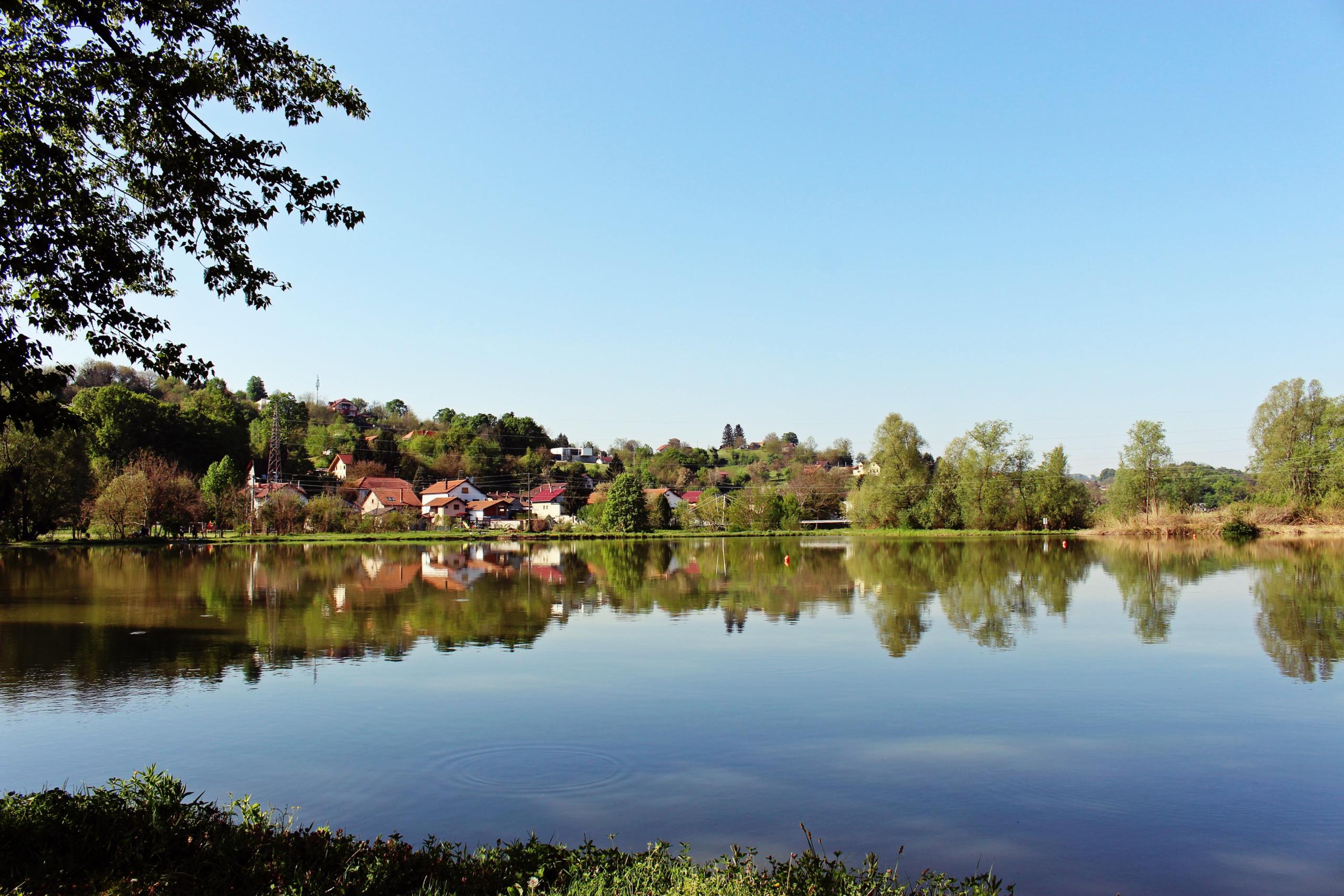
The best place to chill when you visit Ludbreg is Youth island © Ludbreg Tourist Board
To the town's east lie the vast flatlands of the Pannonian basin, to the south, a luscious green carpet covers the gently rolling hills of Zagorje, along the river Drava is the historic region of Podravina, stemming from the foothills of the Alps, to its north, historic Međimurje, then Austria and Hungary. You can see the land around the town juggle with this mixed identity, just as the town does; flat agricultural fields are interrupted by hills like Kalnički gorje or more gentle rises atop which beautiful holiday homes are placed. Nearer the centre of town, ultra-contemporary businesses lie next to routes of ancient pilgrimage. Neither here nor there, Ludbreg exists within a wonderfully mixed topography, with one foot in the past but a sharp eye on the future. 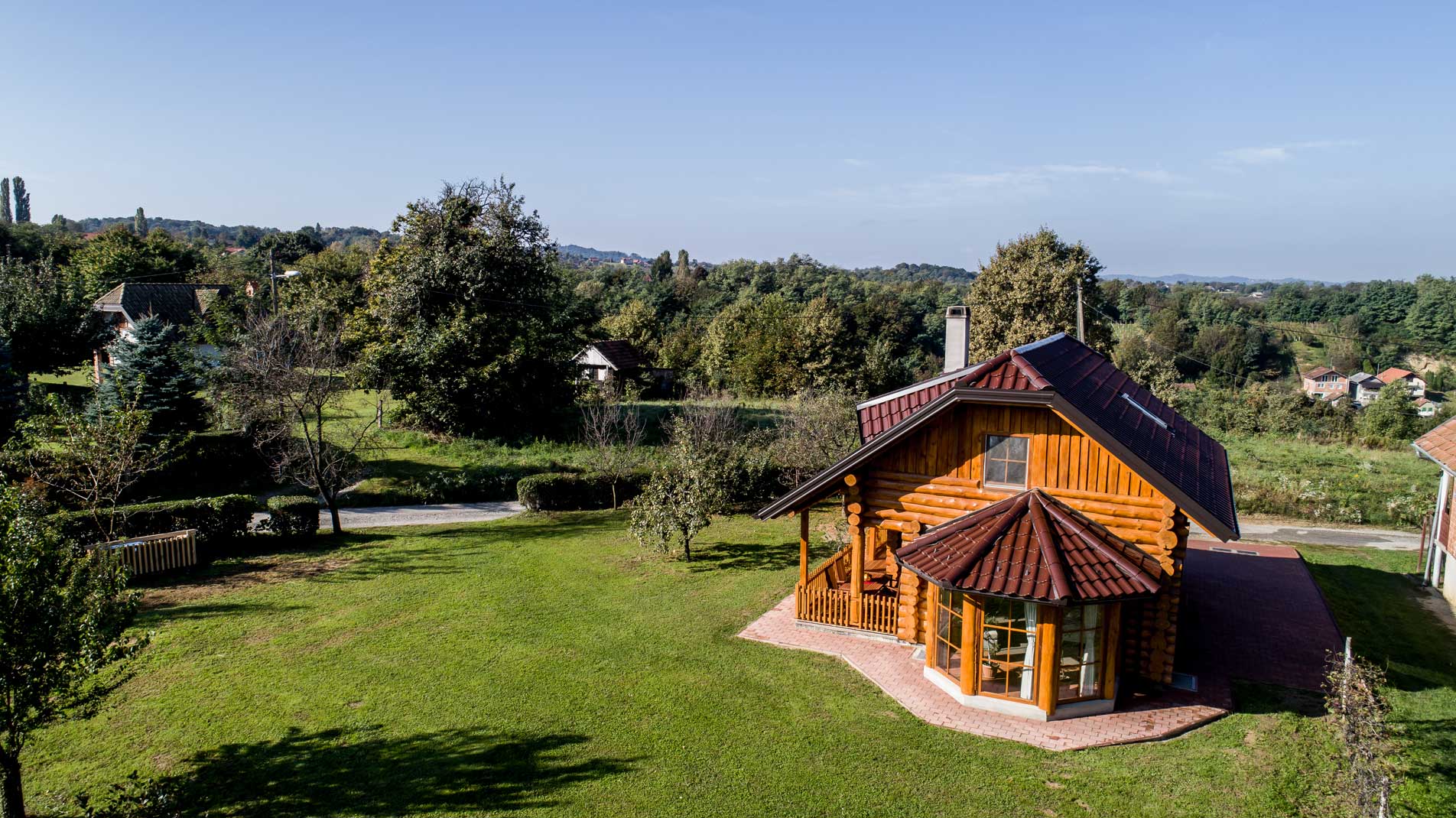
Hazelnut House holiday home, one option of where to stay when you visit Ludbreg © Varaždin Tourist Board
Why visit?
Truth be told, if you visit Ludbreg, you can see all of its sights in a day trip. And the town is perfect for just that. But, by doing so, you probably wouldn't get more than a tourist's glimpse of the place. Ludbreg is actually comprised of thirteen settlements that exist around the centre and it is within these quiet-looking hamlets and villages that most of the town's drive and ambition lie. This is where the people live. And, for a while, you can too. The whole town has a reputation for sustainable living and sustainable growth - pioneering waste management schemes, growing allotments granted to residents without gardens and technically advanced green power solutions. It is in these settlements that you'll find holiday homes designated to agro-tourism and ecotourism. Perfect for relaxing alongside only your nearest and dearest, they hold distinct, unique architecture, some have outdoor swimming pools and all are surrounded by clean, fresh air and nature. 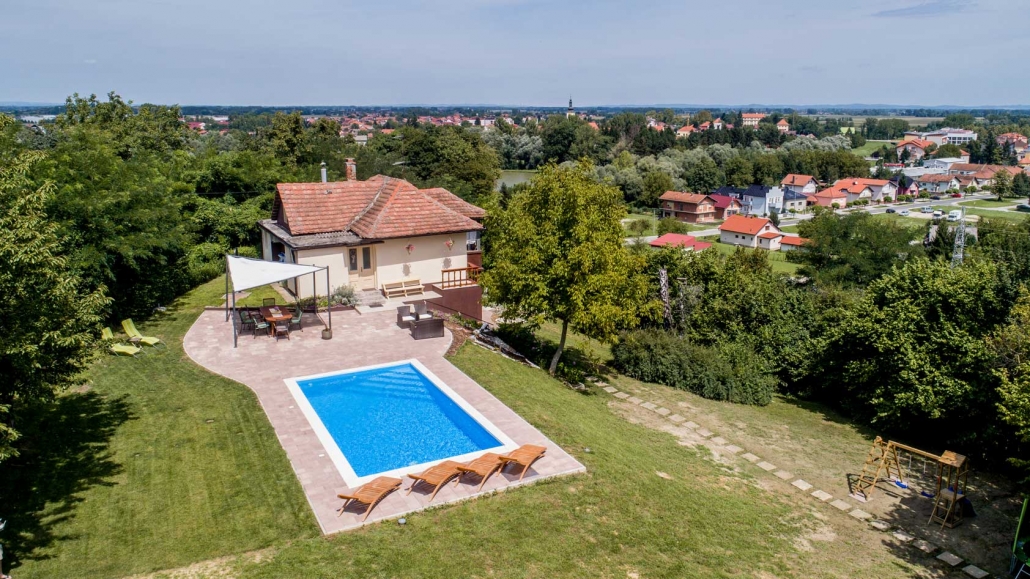
Villa Mila holiday home, another great place to stay when you visit Ludbreg © Varaždin Tourist Board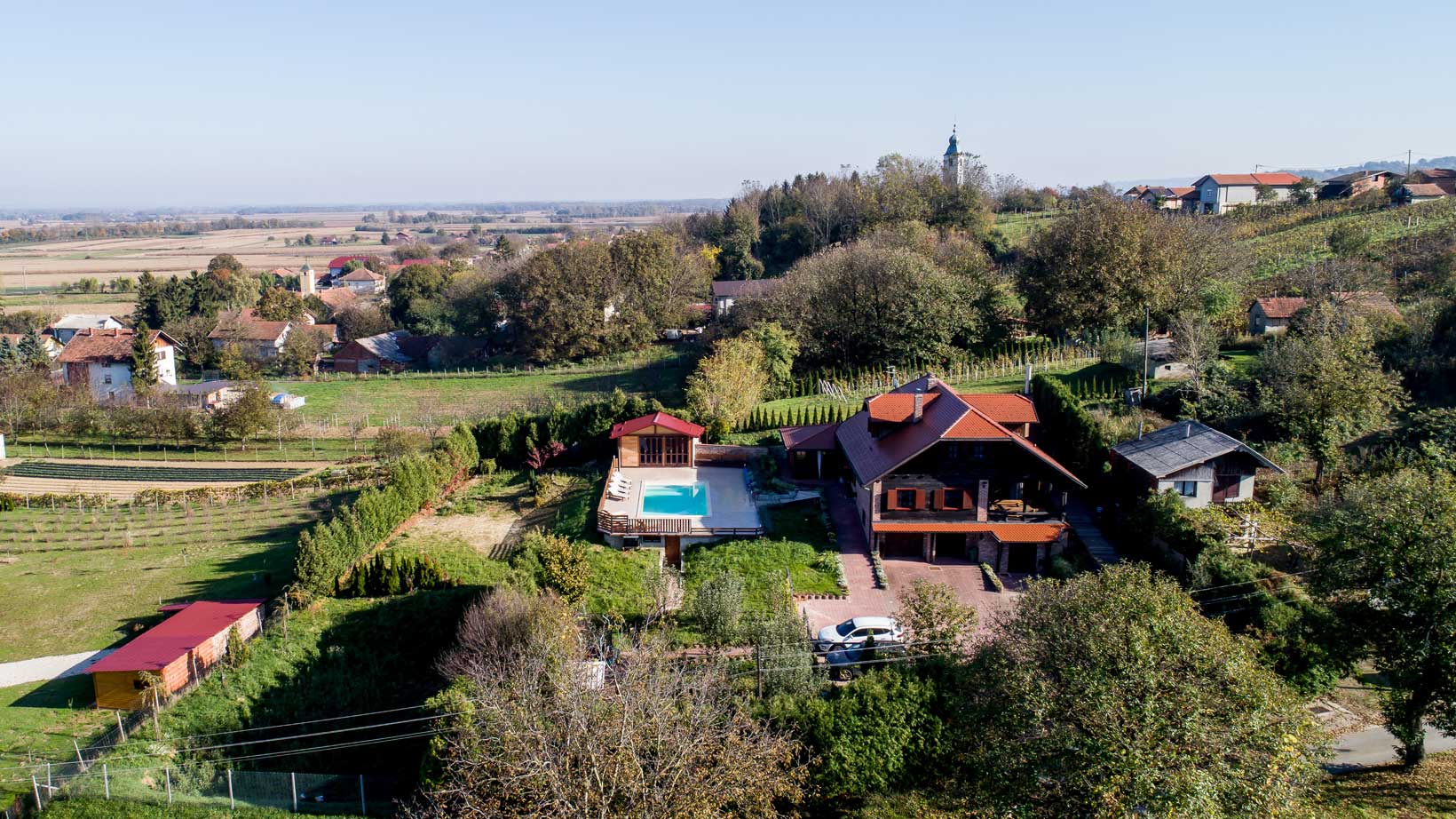
Rural House Gabrijela holiday home - you can get close up to nature and still keep the swimming pool when you visit Ludbreg © Varaždin Tourist Board
The bountiful nature surrounding Ludbreg is one which services the town's ancient industries, traditions and arts & crafts. Some of these you can see or join in with, the most famous being Ludbreg's wine roads. Take a tour of the area's vineyards, cellars and winemakers to sample great examples of continental wine. White wines are their forté and Graševina, Riesling, Pinot Blanc, Pinot Gris, Sauvignon, Chardonnay and Traminac are just some of the major league players available here, alongside rarer names like Moslavac and Manzoni. Muscat, Pinot Noir, Frankovka, Cabernet Sauvignon and Poštenjak can also be sampled.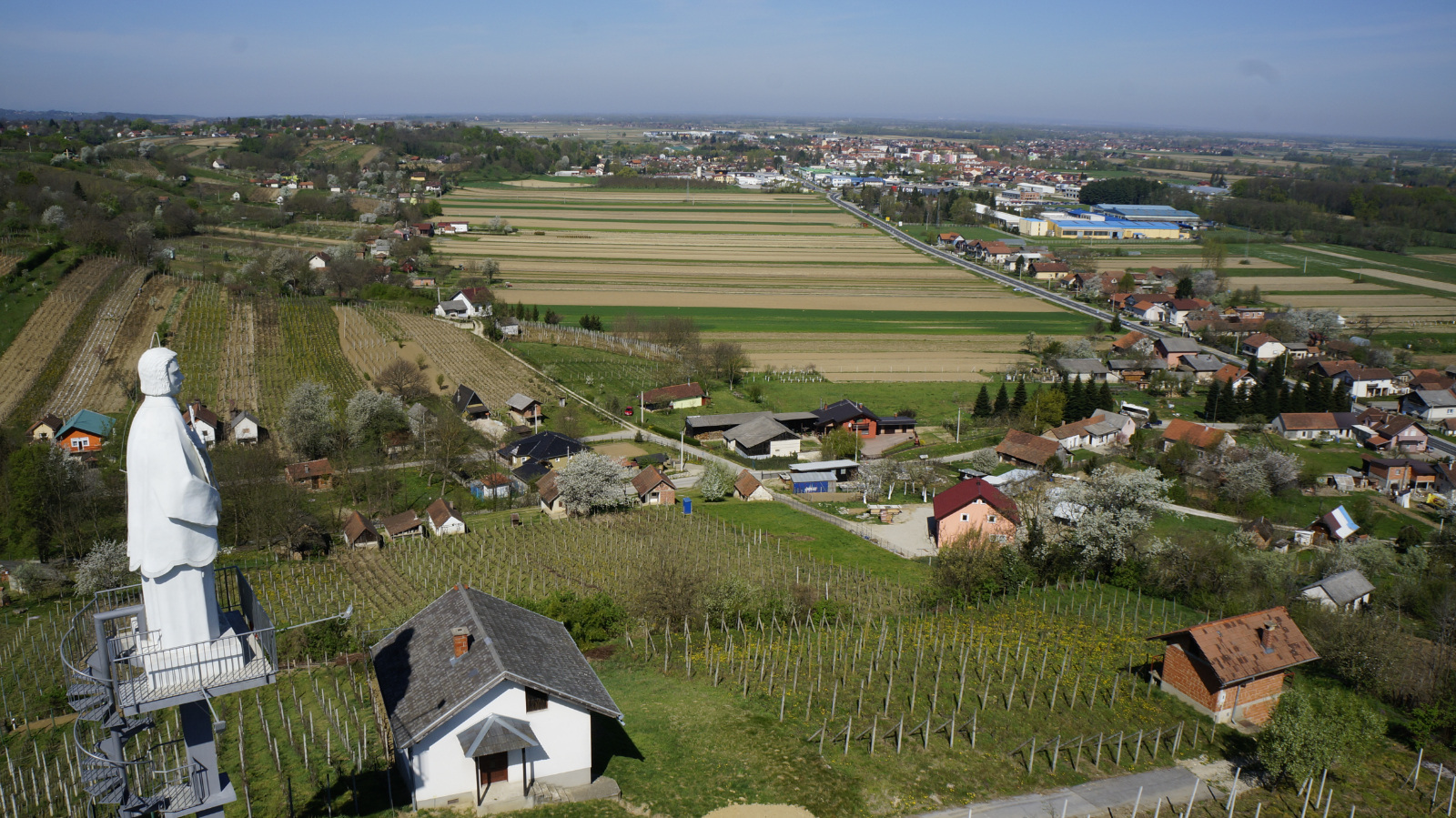
The wine roads surrounding the town are one of the best activities when you visit Ludbreg © Ludbreg Town
Alongside the sights, the other thing to catch when you visit Ludbreg is the events. In these regards, Ludbreg punches well above its welterweight. The town's event calendar is brimming with exciting or entertaining things to see and do. It wasn't so long ago that hundreds of participants and spectators from 33 countries descended on the town for the annual World Model Aircraft Championships. Ludbreg is used to happily hosting such hordes, its institutions beckoning thousands of visitors every year.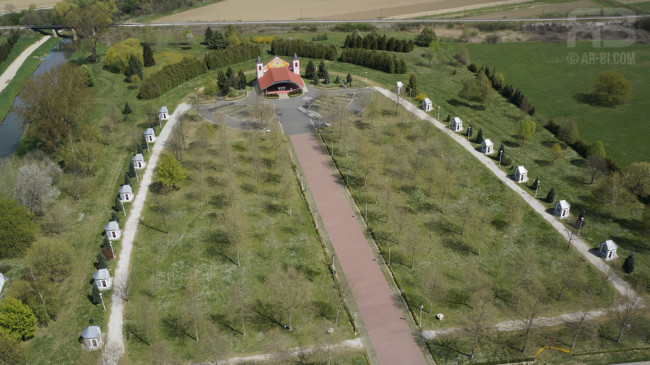
The peaceful approach to the pilgrimage site - one of the more famous reasons to visit Ludbreg © Ludbreg Tourist Board
The most famous of these institutions is the Catholic faith. Whether you believe the town to be named after a returning Crusader or an entranced winemaker, one history of Ludbreg holds a greater clarity due to its acknowledgement by the Vatican. Many people visit Ludbreg on devout pilgrimage because the Blood of Christ is said to exist here. When doubt entered into the mind of a local priest performing the Eucharist, it is said the vessel he held became filled with the actual Blood of Jesus Christ. Pope Julius II began investigating the claim thoroughly, so much so, that the miracle wasn't confirmed until the reign of his successor, Pope Leon X, in 1513. Pilgrims have visited Ludbreg ever since. The relic of the Precious Blood of Jesus is kept in Ludbreg's parish church of the Holy Trinity, although a special site for pilgrims was built on the edge of the town centre in 1992.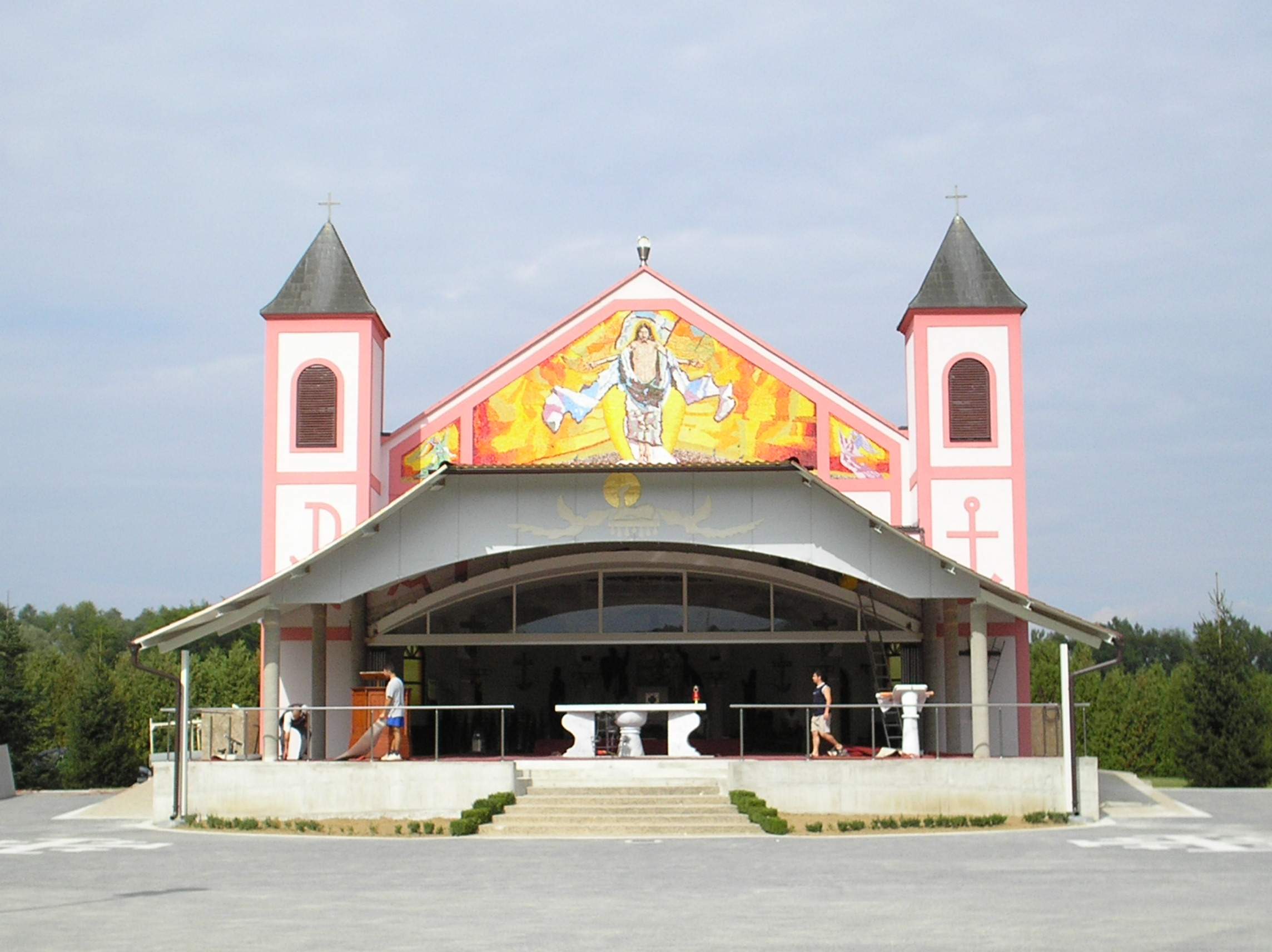
The pilgrimage site which the faithful flock to when they visit Ludbreg © Fraxinus
The most-famous architectural building in Ludbreg (and the prettiest) is the Baroque castle Batthyany. The castle dates from the reconstruction of the older medieval castle on the same site by Count Louis of Batthyany in the mid-18th century and today houses the workshop of the Croatian Restoration Institute. There, painstaking repair work is undertaken on historical items from all over Croatia which have been damaged by the years or in the war of the 1990s. Walking around the ultra-modern town centre of Ludbreg offers no clue that behind this castle's walls such careful preservation of the past is taking place.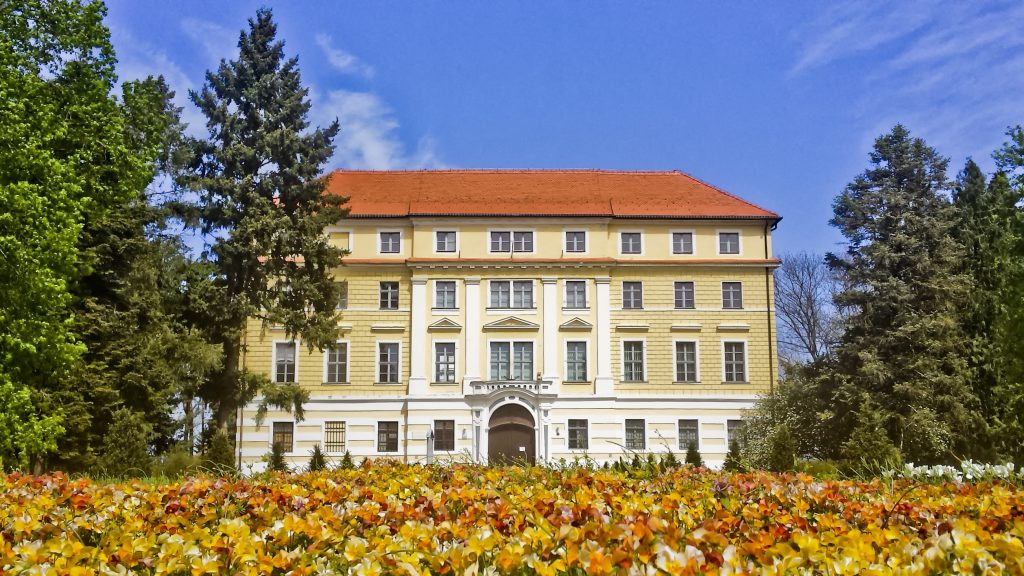
Batthyany castle in Ludbreg © Ludbreg Town
The other great institution of Ludbreg is also one which dedicates its life to preserving the past, but the history it protects belongs to the people, not the church. The cultural and artistic society KUD Anka Ošpuh, named after a female Partizan hero, has been operating in Ludbreg since 1976, although its roots are older. Many female-led charitable organisations operate in and around Ludbreg. That much of this work has existed in such hands for up to 150 years is simply remarkable, particularly within a broader Croatian society still viewed as patriarchal. Traditionally, while the young men of Ludbreg were drawn to more manly pursuits such as sports, bombastic brass instrument-playing and all-male choirs rooted in those of the church, the town's women were instead occupied with chores, charity work and the songs, dances and costumes of folklore. Folklore societies and their preservation of local, peasant traditions became incredibly popular all over Croatia after the Second World War. Early examples in the area of Ludbreg include Braća Kavurić from Martijanec (founded 1945) and that of Kutnjak (1947) with similar established in Sveti Đurđ, Sesvete Ludbreški, Dubovica and Vrbanovac. 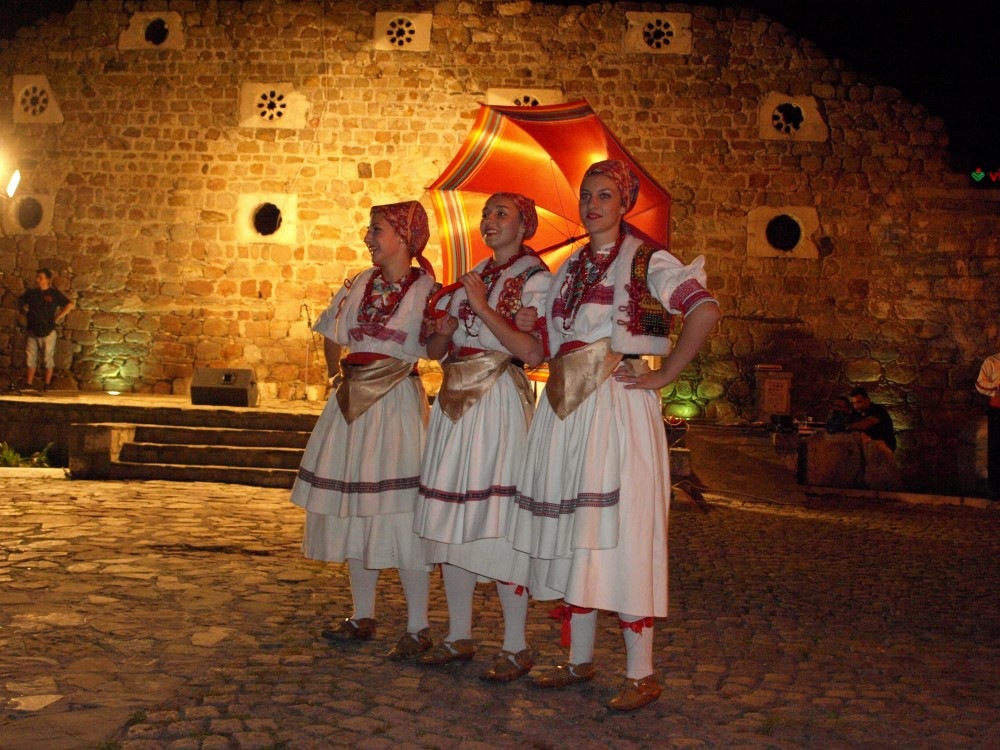
Contemporary members of folklore society Anka Ošpuh © Ludbreg Town
These village societies were mixed, but with the absence of any such society in central Ludbreg, it took 22 women to form the town's own. They made a great success of doing so. Although initially so poor with resources they had to practise in the basement of factories and local houses, by 1977 the society had grown to contain 79 members and was able to establish its own group of attached tamburica musicians and an all-female choir. As their reputation grew, the society absorbed many key contributors from similar groups in surrounding villages and their assets. To the 12 valuable Moslavina folk costumes with which they began, KUD Anka Ošpuh were able to add examples from Podravina, Slavonia, Dalmatia, Lika and even some worn by Croats in Vojvodina (present-day Serbia). Many of these costumes are still preserved or worn by society members to this day, kept alive, like the songs and dances of the region, by the society. These days, KUD Anka Ošpuh is one of the most highly regarded in Croatia and has performed all over the country, plus internationally at folk song and dance festivals. Its essential work is passed down to children and young people of the area in order that these traditions survive. Highly skilled and beautifully presented, they offer a glimpse of authentic and historic local culture. If you get the chance to see them, you simply must.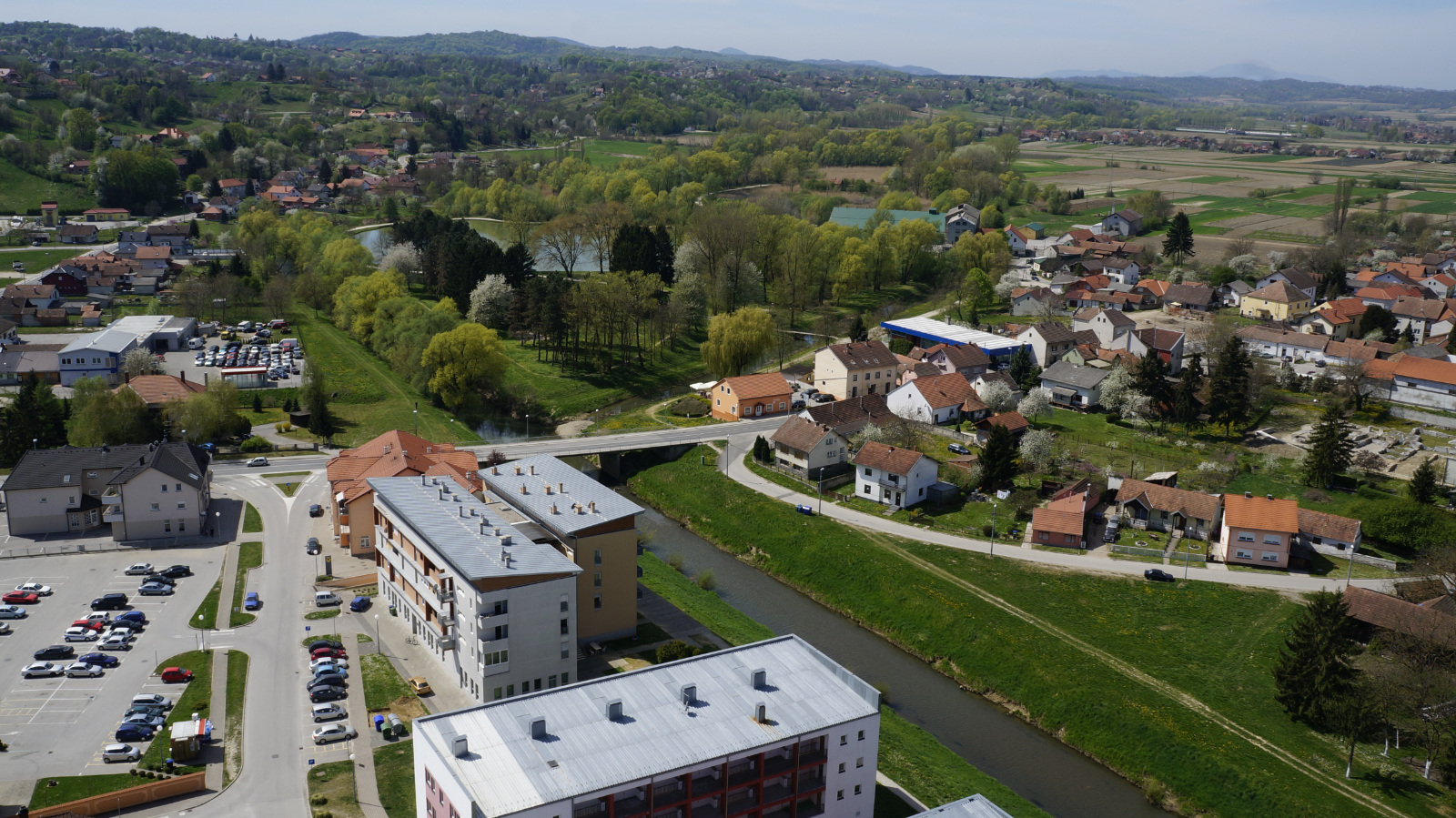
Ludbreg © Ludbreg Town
How to get to Ludbreg: The town lies approximately 100 kilometres by road from Zagreb, with bus or car being your options. Ludbreg has its own train station with trains running direct to Zagreb, Osijek and Varaždin.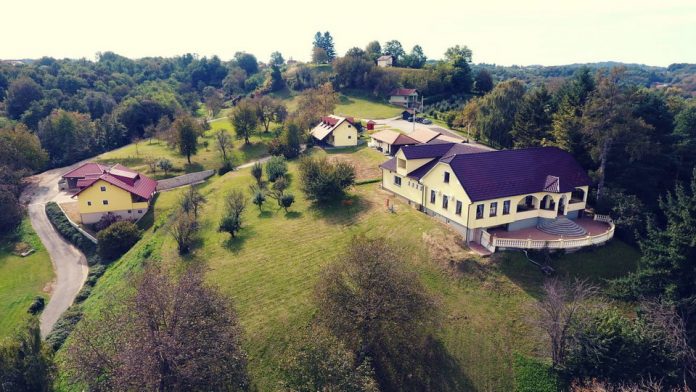
Črn-Bel restaurant © Črn-Bel restaurant / Luka Krušec (LuMedia)
Where to eat: Surrounded by vineyards and beautiful nature, the Črn-Bel restaurant is a brilliant spot for lunch or dinner. They do great grilled meats, superior pizzas from a wood-fired oven and sharing platters, with most ingredients sourced locally. Restoran Raj in the town centre is much more of an informal, family place, with pizzas for the kids and shared grills or deep-fried seafood for the parents.
Where to drink: Pivnica Mejaši is a great pub in the centre of town where you can refresh yourself. They have a lovely, covered outdoor terrace and a good pub-grub menu, including pizzas, which will satisfy for lunch or an informal evening meal.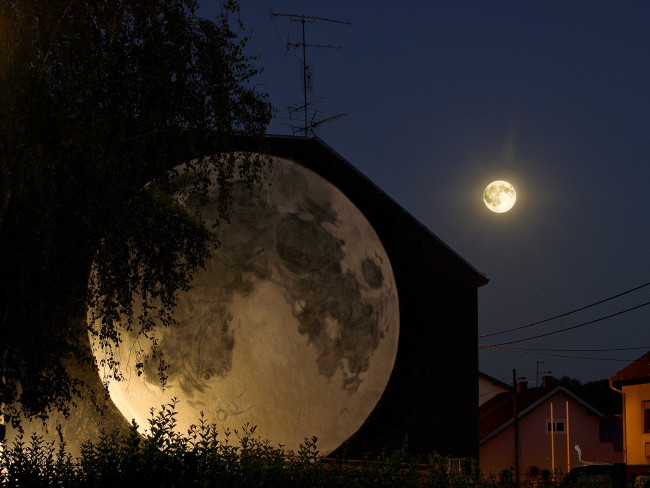
Ludbreg's first piece of street art is a mural of the moon © Ludbreg Tourist Board
What's new: Although the 'Centre of the World' is the star of the town's main square, you'll not miss several new additions to their menu of monuments. The latest is an artwork dedicated to young, local athlete Sara Kolak, a javelin player who earned a Gold medal for Croatia at the 2016 Olympics. She shares the square with a fountain, a photo opportunity spot and a remarkable solar-powered tree where you can charge your phones and other devices for free. For the cool cats, the town has a brilliant mural of the moon on one building facade – it's Ludbreg's first street art piece. The town will host a conference on cycling tourism from 16 – 18 September 2020.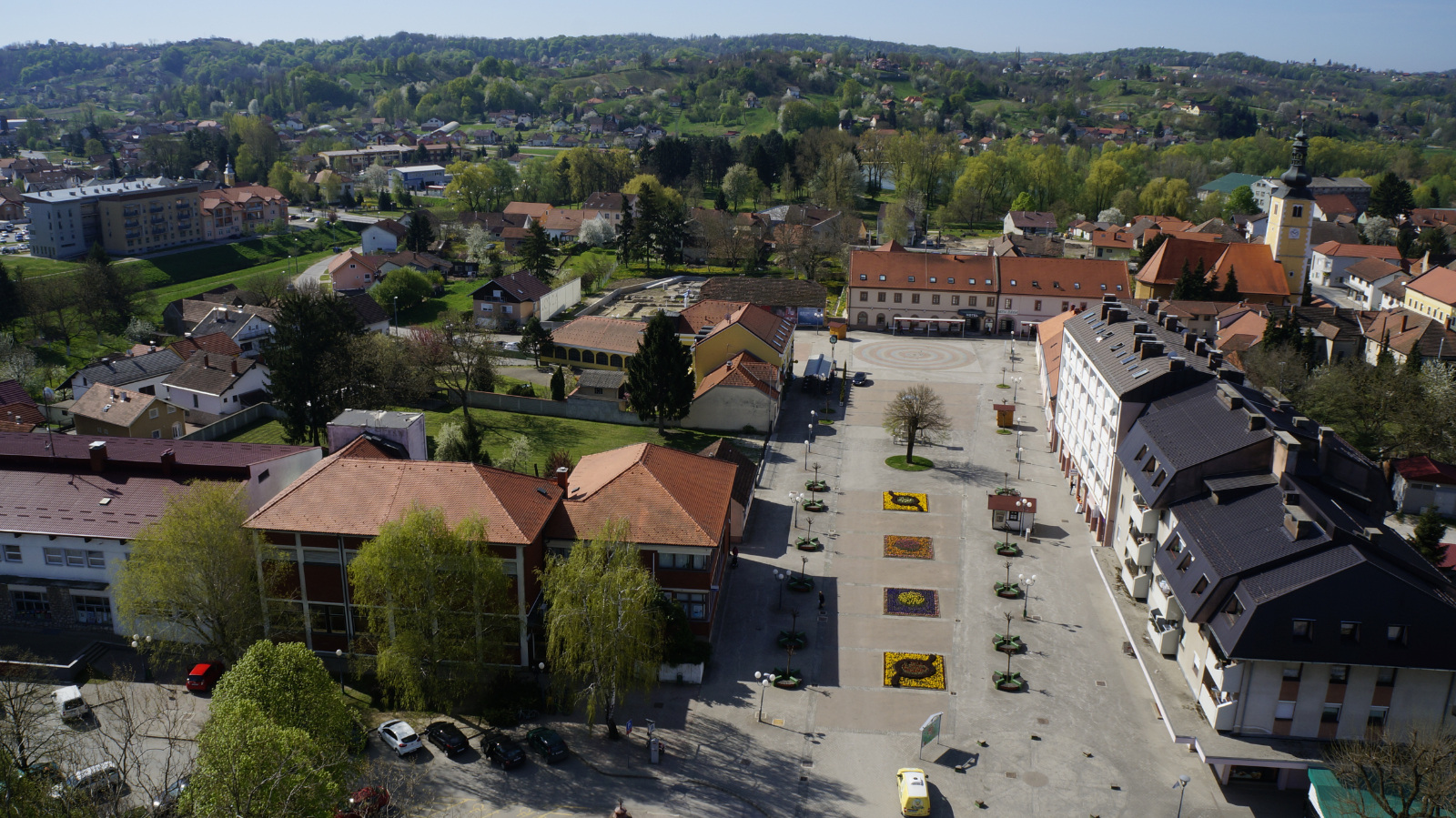
Ludbreg's town centre © Ludbreg Town
What not to miss: For a small place, the list is huge. Don't miss the parish church of the Holy Trinity, its interior is delightful. You must visit the castle too and take the pilgrim's walk up to the modern ecclesiastical point of worship. LUMEN, a Ludbreg youth organisation, hold great music and theatre events. Centre of the World Day is April 1 and everyone joins in during the town's big day. The fountain on the central square flows with wine for the occasion. The town's carnival sees joyful residents march the chilly streets in costume. It's 164 years old and takes place on Shrove Tuesday. Ludbreg's Advent festivities grow year upon year. Also in winter, at the end of January, the town's winemakers present their fresh batches at the Young Wine Days.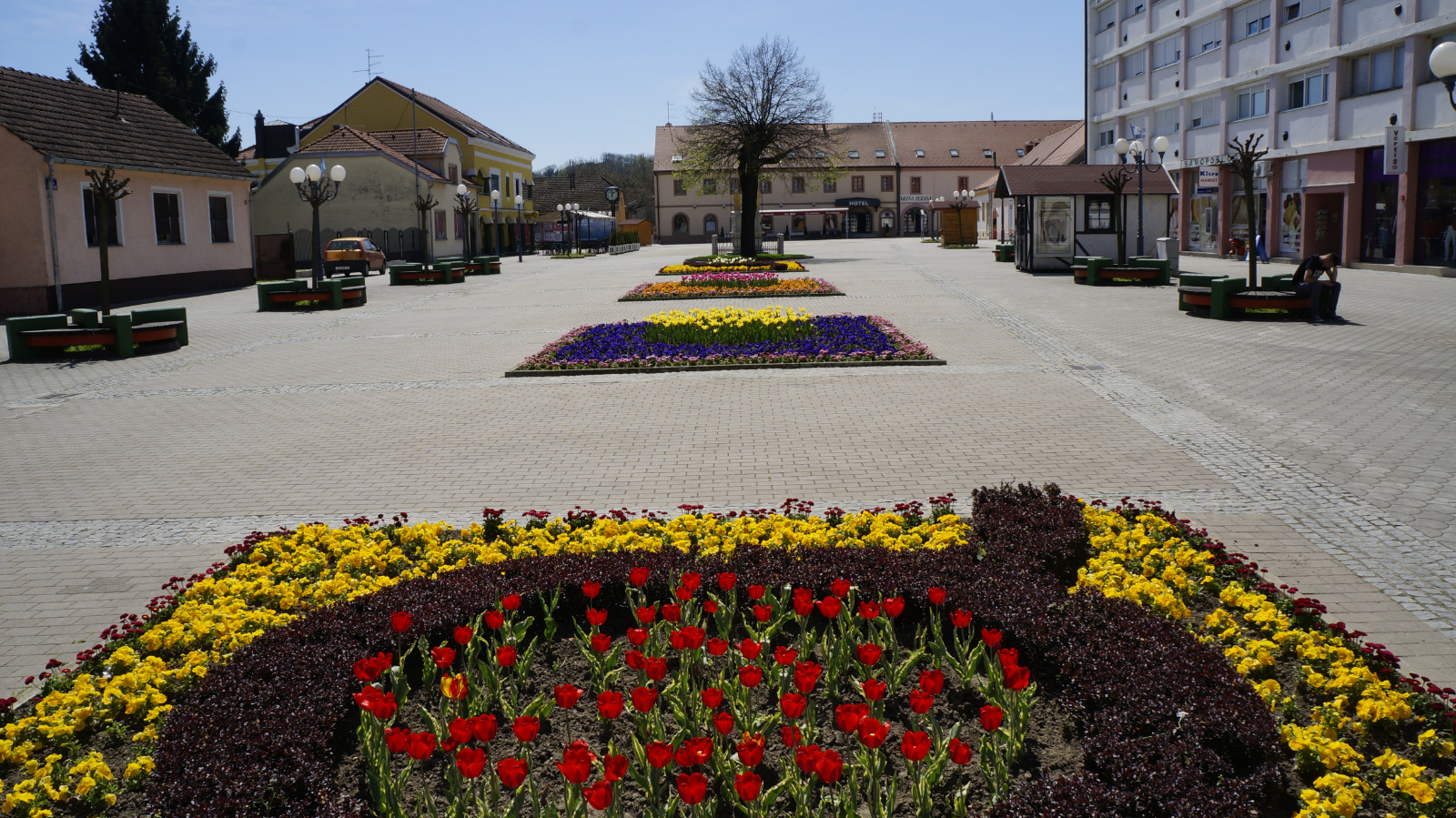
Ludbreg's central square. During its three-day International Flower Festival, the town explodes with even more natural colour © Ludbreg Tourist Board
The town's three-day International Flower Festival is the second biggest in Croatia and is an explosion of natural colour. You can visit it at the end of April / beginning of May. The Ludbreg Bike Tour is a 15 kilometre run around the town, with a great afterparty at the picturesque Youth Island (main picture). Two more great parties are Idemo Otok in June and Crazy Island in August. Strange to imagine such a small place hosting two electronic music festivals of such far-reaching repute, but it does. Young dance music enthusiasts from all over Croatia travel here to attend them. Again, they take place on Youth Island. Although pilgrims visit throughout the year, many reserve the journey for the seven days surrounding Holy Sunday. KUD Anka Ošpuh holds folklore events throughout the year including a memorial performance for former president Mirjana Bošnjak, a springtime celebration, Ludance (which focusses specifically on local folklore), a wintertime celebration, Christmas show and, pick of the bunch, Folklore Meetings in the Centre of the World, during which they're joined by outside folklore societies. KUD Anka Ošpuh's great tamburica orchestra also play many dates independently, as do the once-attached but now independent, all-female Podravina choir.
What to buy: Ludbreg has had a beekeeping society for over 70 years and local beekeepers know their stuff. Ludbreg honey is a great gift to take home, as are any of the bottles of fine wine produced around the town.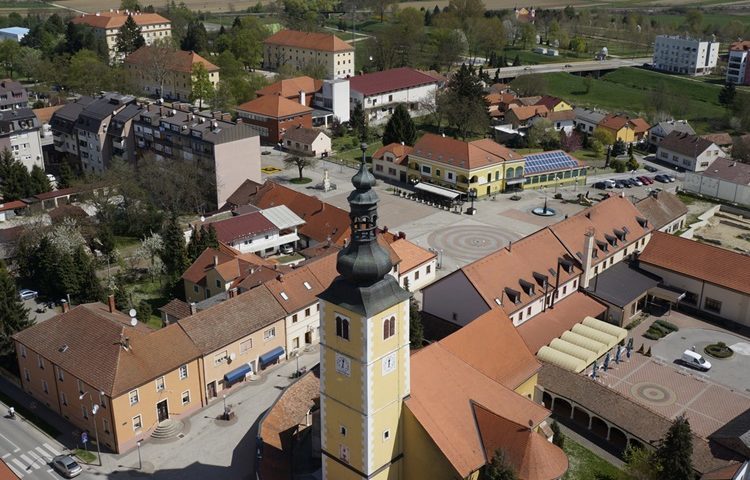
Ludbreg's town centre © Ludbreg Town
On these links you can read about the other destinations in our The Croatian Road Less Travelled series:
Osijek - the capital of Slavonia, on the banks of the Drava
Donji Miholjac - a hidden gem in the heart of the Pannonian basin
For the latest news from Ludbreg, check out the dedicated TCN section.
For the latest travel info, bookmark our main travel info article, which is updated daily.
Read the Croatian Travel Update in your language - now available in 24 languages
Meet the Wine Roads of Croatia: Ludbreg in Varazdin County
December 20, 2019 - Some regions are better organised for wine tourism than others in Croatia - meet the Ludbreg wine road.
Living on a beautiful island of wine on Hvar, as I did for many years, in a picturesque region of Dalmatia whose wines are exported all over the world, I was constantly amazed that there are no official organised wine roads, as this is surely a great opportunity not only for tourism but to develop and promote one of the strongest aspects of life in Dalmatia.
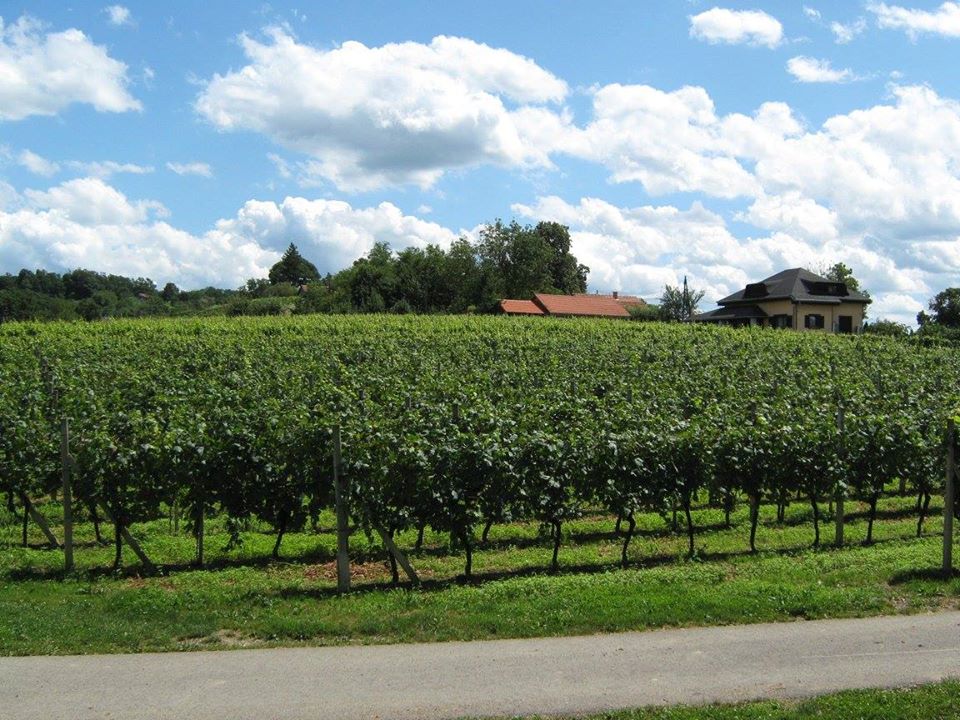
Cross the border into neighbouring Bosnia and Herzegovina, for example, and the first sign that you see is promoting the wine road of Herzegovina. And so too, all around Croatia, but sadly not in Dalmatia - at least for now. Things are a little more organised elsewhere in the country, including a very cute corner of northern Croatia, where white wines are king, and the closest vineyards to the centre of the world - Ludbreg in Varazdin County, which I first visited a few years ago. I was immensely impressed by the effort put in by enthusiastic local winemakers and restaurants to create the Ludbreg Wine Road, as well as the quality of the wines themselves. In their own words (a translation of their Facebook page, which you can follow here):
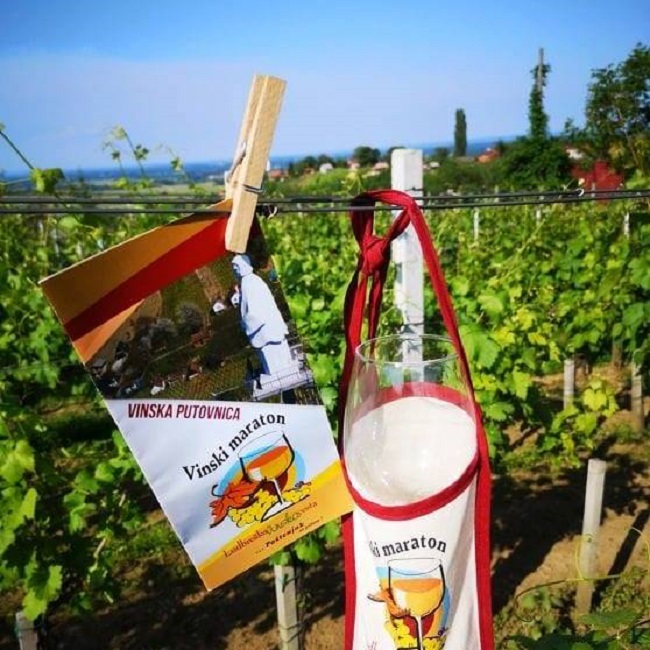
Once upon a time, in the 12th century, in the hills above Iovia (Ludbreg) lived a beautiful Ludberga. She was a skilled winegrower and she always worked hard in her vineyard and produced her famous sweet wine. At that time, everyone knew about Ludberga’s wine and beauty. As the years passed without Ludberga, Iovia’s Hills (the Ludbreg Winegrowing Area) were slowly forgotten. Wishing to restore the Ludbreg Winegrowing Area to its former lustre, the Ludbreg Wine Road was established.
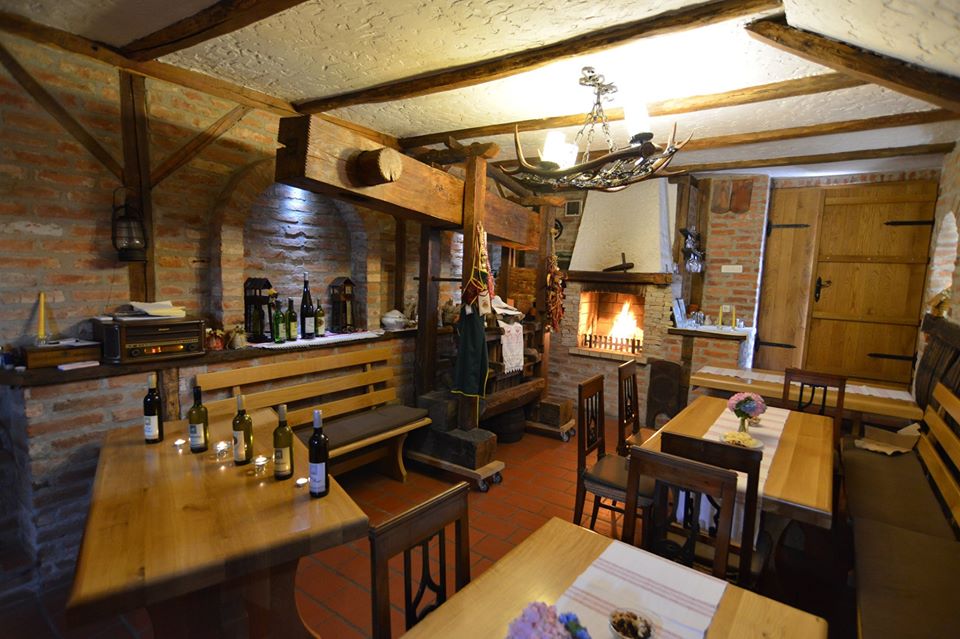
The Ludbreg Wine Road is located on the hills of the Ludbreg Winegrowing Area, which is an integral part of the Zagorje-Međimurje sub-region in the Continental Croatia Winegrowing Region.
The aim and purpose of the association is to promote wine tourism and its tourist presentation through a comprehensive wine area whose wine road includes wine checkpoints (wine-houses and cellars), and thus expands and stimulates the development of tourism, not just in the Town of Ludbreg, but also in the entire Ludbreg area and beyond.
The Ludbreg Wine Road includes: Restaurant/Tasting Room “Arabella” Globočec, Wine Cellar “Makar”, Wine House “Kirić”, Restaurant “Črn-Bel”, Winery “Stručić”, and Tasting Room “Kežman”.
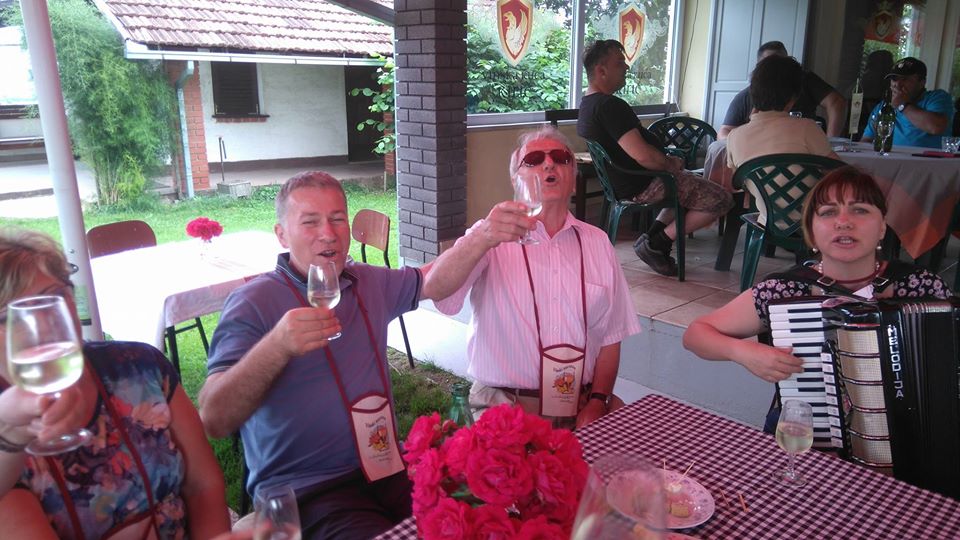
Here you can try: Graševina, Riesling, Pinot Blanc and Pinot Gris, Sauvignon, Green Silvanac, Chardonnay, Traminac, Moslavac and Manzoni, Muscat and Pinot Noir, Frankovka, Cabernet Sauvignon and, of course, our Poštenjak. In addition to the wines, the offer includes authentic “hilly” delicacies from the Ludbreg area.
Poštenjak, or “wine without malice”, is a quality wine that contains 70 percent of Graševina, 20 percent of Chardonnay and 10 percent of Pinot Gris. The wine is named after a popular character, honest and naive Dudek from the Croatian TV series “Gruntovčani”, written by screenwriter Mladen Kerstner, who was originally from Ludbreg.
The Ludbreg Wine Road includes a statue of St. Vincent with a viewpoint. This statue of St. Vincent is the tallest such statue in Croatia and even in the world, and offers a view of Varaždin County, Koprivnica-Križevci County, Međimurje County and neighbouring Hungary.
Also, we always take care of cleanliness and environmental protection of the area around the wine road.
So, if you would like to taste or drink a glass of wine and try some “hilly” delicacies, you can find us in the very centre of the world.
Learn more about the wines of Lubreg in the video below from G.E.T. Report (in Croatian), and to learn more about one of the most fascinating towns in all Croatia, check out TCN's visit to Ludbreg here - amazing place.


